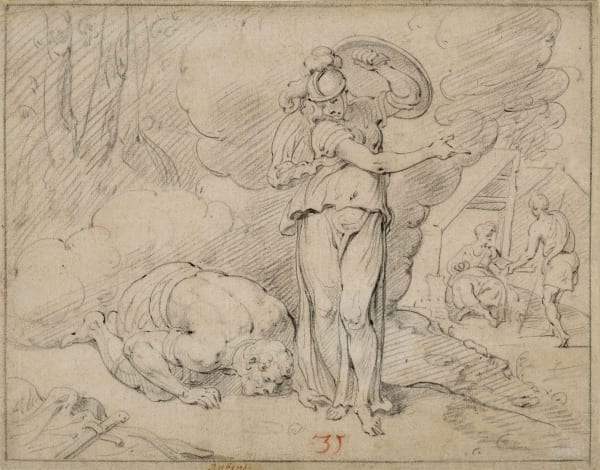Theodoor van Thulden ('s-Hertogenbosch 1606 - 1669)
Thedoor van Thulden was born in 's-Hertogenbosch in 1606, the eldest of nine. His father was a silversmith. At age fifteen van Thulden went to Antwerp, where he studied with the little-known portrait painter Abraham Blyenberch. In 1626 he became a member of the Antwerp guild of St Luke; he would be its dean in 1639 and 1640. Although he was never a pupil of Rubens, he was greatly influenced by his work and collaborated with him on several occassions, notably on work for the Torre de la Parada in Spain in the years 1636-38. Between 1631 -33 the artist stayed in Paris, where he copied Primaticcio's and dell'Abate's frescoes at Fontainebleau, which he also engraved. In 1635 van Thulden married Maria van Balen, the daughter of the painter Hendrick van Balen. Their daughter Maria Anna was born in 1636.
In 1635 van Thulden collaborated on the decorations for the Joyous Entry of the cardinal-infante Ferdinand, a project overseen by Rubens. He was also asked to produce the engravings for a commemorative book, the Pompa Introitus Ferdinandi, which was only published in 1642 and caused him considerable financial losses. Plagued by money worries, he went back to his native 's-Hertogenbosch in 1644, where he would remain for the rest of his life.
Van Thulden mostly painted history pieces and mythological scenes, and was one of the best decorative painters of his time. Stylistically, the mannerist influences from his early career were soon replaced by Rubens' baroque style idiom. From the 1640's onwards, he developed more of a personal style, which was more elegant and classicist. The present painting, which is signed and dated 'T. van Thulden fec AE 1663' at the bottom left, dates from this later period and represents The Triumph of the Virgin Mary.
The Mother of God is portrayed standing, treading on a snake coiled around a globe. Supporting the Child on her right arm, she is holding a white lily in her left hand, a symbol of her purity. On her right, Mary is flanked by some of the Blessed who are glorifying her. There are two angels on her left, protecting her with a shield, from the devil, who is represented as a fire-breathing, black dragon with a long tail.
This representation is consistent with the typology of the Virgin who is triumphing over Evil, and, more specifically, over Heresy. This iconographic model was very popular in monumental sculpture in Antwerp in the 17th and 18th centuries, so much so, that even today the facade of many an old house in Antwerp is still decorated with a stone image of Maria de Victoria. In addition, there are also numerous examples known of 17th-century Antwerp ivory carving and paintings on this theme. The canvas presented here is in keeping with the fighting spirit of the Counter Reformation and the central role thereby assigned to Maria Immaculata.
Provenance
Private collection, Austria.
Literature
A. Roy, exh. cat.: 1991-1992, ‘s-Hertogenbosch-Strasbourg, Theodoor van Thulden. Een Zuidnederlandse barokschilder. 1606-1669, Zwolle-’s-Hertogenbosch-Strasbourg, 1991, 270, no.154.
- X
- Tumblr
-
 Theodoor van Thulden ('s-Hertogenbosch 1606 - 1669)The Lamentation; a Design for a stained-glass Windowpen and ink over black chalk on 5 sheets on laid paper195 x 55 mm x 5
Theodoor van Thulden ('s-Hertogenbosch 1606 - 1669)The Lamentation; a Design for a stained-glass Windowpen and ink over black chalk on 5 sheets on laid paper195 x 55 mm x 5 -
 Theodoor van Thulden ('s-Hertogenbosch 1606 - 1669)Minerva and Odysseus on Ithacablack chalk on laid paper198 x 250 mminscribed with the number '31'; inscribed 'Rubens'
Theodoor van Thulden ('s-Hertogenbosch 1606 - 1669)Minerva and Odysseus on Ithacablack chalk on laid paper198 x 250 mminscribed with the number '31'; inscribed 'Rubens' -
 Theodoor van Thulden ('s-Hertogenbosch 1606 - 1669)The Lamentation: a Design for a stained-glass Windowpen and ink over black chalk on 5 sheets on laid paper195 x 55 mm x 5
Theodoor van Thulden ('s-Hertogenbosch 1606 - 1669)The Lamentation: a Design for a stained-glass Windowpen and ink over black chalk on 5 sheets on laid paper195 x 55 mm x 5


